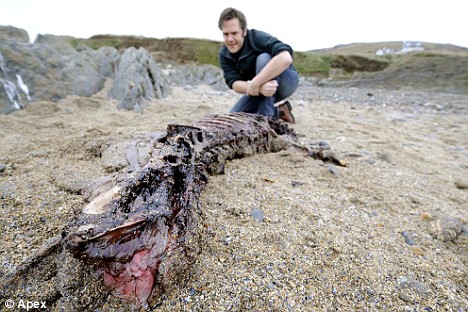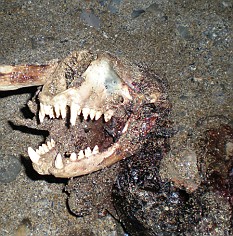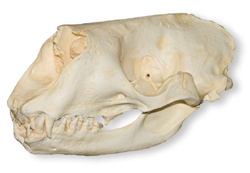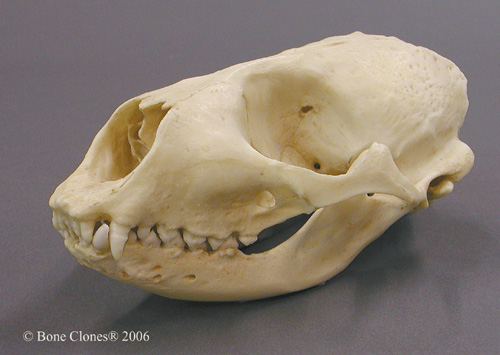
January 9, 2009
Something washed up ashore on a Croyde Bay beach, near Exmoor, UK. The British tabloids are having a field day trying to link it to the Beast of Exmoor. But, of course, it is not an Alien Big Cat or even a Mystery Cat. It is some form of marine mammal, for it has remnants of flippers, and well, it is a beach, right?
The ABC was blamed, but the seal’s been named, baby. Where’s the beast?

The Daily Mail reported on January 9th, that it is five feet long, with a
…powerful chest, and what could be the remains of a tail.
A carcass of an animal that has washed up on a beach in North Devon has left many of the locals speculating that it is the body of the infamous Beast of Exmoor.
Had it been washed up on any other shore, it might simply have been dismissed as the unfortunate remains of a large dog.But this was North Devon. And folk in these parts have learned that sightings of mystery animals are likely to mean only one thing – the Beast of Exmoor is back.
***
‘It’s only about five miles away to Exmoor by sea, it could easily have floated down.’
PC Tucker added: ‘It’s a good 5ft and it has black fur. It certainly looks quite beast-like with those teeth.’
***
Samples sent for analysis revealed that the Beast of Croyde Bay was simply a grey seal.
Decomposition meant its flippers had vanished to reveal bones that looked like they might have been limbs.

The Exmoor Beach Beast skull.
As compared to…

Halichoerus grypus Grey Seal (northern Atlantic and southern Arctic oceans)

Phoca vitulina Harbor Seal (coastal areas of the Atlantic and Pacific oceans)
Now for something completely different…
< 

Enhydra lutris Sea Otter (West Coast, North America)
Meanwhile, early this morning, the Centre for Fortean Zoology sent out a press release:
Two nights ago a carcass was washed up on Croyde Beach in North Devon. The Centre for Fortean Zoology, [CFZ], were informed, and they sent a three-man team of investigators – Graham Inglis (52), deputy director, Oll Lewis (28), ecologist, and Matthew Osborne (28), one time Bideford town councillor, trainee Methodist lay preacher, and all round good egg – to find out what the fuss was about. The CFZ are the world’s largest mystery animal research organisation, and they happen to be based less than 30 miles from where the mysterious carcass was washed up.
Various newspapers and media pundits have claimed that what was washed up was the cadaver of the beast of Exmoor – the notorious big black cat which for decades has been selling newspapers and killing sheep with equal abandon. From the photographs we had been e-mailed, it was pretty obvious that this was nonsense, that the CFZ would not be doing their job properly if they just took a cursory look at the photograph on their computers, before dismissing the matter from their minds.
The body was about 5 ft long, and – according to the team – reeked to high heaven. It was obviously a member of the seal family, and is almost certainly the remains of an unfortunate grey seal (Halichoerus grypus), which is a fairly common resident of the wilder parts of the Bristol Channel. However, there is an outside possibility that it could be something more exciting. One of the experts who first viewed of the photographs suggested that it looked like the skull of a sealion. There are seven species in the world, but with the exception of one species found on the coast of Argentina, all sealions are restricted to the Pacific Ocean. However, in the 1980s a Steller’s sealion turned up on the Brisons – two tiny islets, a mile out to sea from the west coast of Cornwall. No one knew how it got there, and – as far as we know – it may still be there today.
Experts will be examining the skull and other samples over the next few days, and will hopefully have a conclusive answer. So, although it certainly isn’t anything to do with the beast of Exmoor, it might just be only the second sealion ever to grace these shores.
Please note, according to the Daily Mail, this morning, “Samples sent for analysis revealed that the Beast of Croyde Bay was simply a grey seal.”
That would be Halichoerus grypus, a grey seal.
~~~Updated clarification: It appears that only the CFZ has had this material for safe keeping and identification purposes (despite silly claims the skull was “stolen” according to late media accounts). It is getting to be all so circular, and further new info will be forthcoming.
Finally, see Darren Naish, here.
About Loren Coleman
Loren Coleman is one of the world’s leading cryptozoologists, some say “the” leading living cryptozoologist. Certainly, he is acknowledged as the current living American researcher and writer who has most popularized cryptozoology in the late 20th and early 21st centuries.
Starting his fieldwork and investigations in 1960, after traveling and trekking extensively in pursuit of cryptozoological mysteries, Coleman began writing to share his experiences in 1969. An honorary member of Ivan T. Sanderson’s Society for the Investigation of the Unexplained in the 1970s, Coleman has been bestowed with similar honorary memberships of the North Idaho College Cryptozoology Club in 1983, and in subsequent years, that of the British Columbia Scientific Cryptozoology Club, CryptoSafari International, and other international organizations. He was also a Life Member and Benefactor of the International Society of Cryptozoology (now-defunct).
Loren Coleman’s daily blog, as a member of the Cryptomundo Team, served as an ongoing avenue of communication for the ever-growing body of cryptozoo news from 2005 through 2013. He returned as an infrequent contributor beginning Halloween week of 2015.
Coleman is the founder in 2003, and current director of the International Cryptozoology Museum in Portland, Maine.
Filed under Alien Big Cats, Breaking News, CryptoZoo News, Evidence, Out of Place